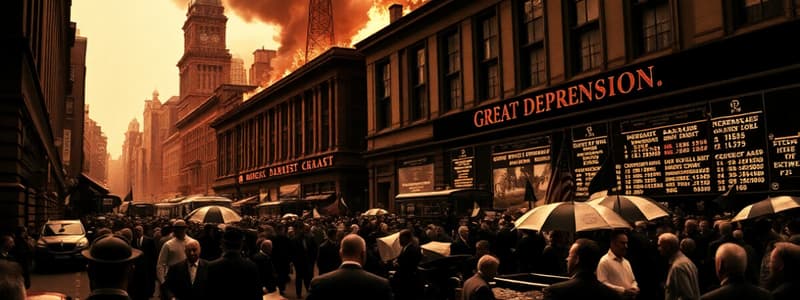Podcast
Questions and Answers
Which factor contributed significantly to the United States transforming into a global financial center after World War I?
Which factor contributed significantly to the United States transforming into a global financial center after World War I?
- Increased tariffs that stimulated economic relationships with European countries.
- Decreased industrial output due to wartime destruction.
- The US remaining neutral throughout World War I.
- The role of American industry in supplying the Allied war effort. (correct)
How did the Smoot-Hawley Tariff impact the American economy during the Great Depression?
How did the Smoot-Hawley Tariff impact the American economy during the Great Depression?
- It opened up new trade relationships, thus alleviating pressure on domestic industries.
- It spurred retaliatory tariffs from other countries, decreasing the foreign market for American goods. (correct)
- It had no significant impact, as the Depression was primarily caused by internal factors.
- It successfully boosted American agriculture and consumer goods, leading to increased exports.
How did the economic policies of the Weimar Republic in Germany contribute to the rise of the Nazi Party?
How did the economic policies of the Weimar Republic in Germany contribute to the rise of the Nazi Party?
- By avoiding debt and maintaining economic stability throughout the 1920s and 1930s.
- By cutting spending rather than increasing it to spur the economy, worsening the economic situation. (correct)
- By increasing taxes on German citizens to quickly pay off war reparations.
- By investing heavily in social programs that alleviated the effects of the Depression.
In what way did the American immigration system reflect the economic anxieties of the Great Depression?
In what way did the American immigration system reflect the economic anxieties of the Great Depression?
What direct effect did the drought in the Southern Plains have on the Great Depression?
What direct effect did the drought in the Southern Plains have on the Great Depression?
How did the practice of buying stocks 'on the margin' contribute to the stock market crash of 1929?
How did the practice of buying stocks 'on the margin' contribute to the stock market crash of 1929?
What role did American demands for loan repayment play in the global spread of the Great Depression?
What role did American demands for loan repayment play in the global spread of the Great Depression?
What was the initial event that triggered the wave of sell-offs and panic during the stock market crash of 1929?
What was the initial event that triggered the wave of sell-offs and panic during the stock market crash of 1929?
How did the Great Depression contribute to Adolf Hitler's rise to power in Germany?
How did the Great Depression contribute to Adolf Hitler's rise to power in Germany?
What was the primary intention behind President Herbert Hoover's instruction to the State Department regarding the 'likely to become a public charge' (LPC) clause?
What was the primary intention behind President Herbert Hoover's instruction to the State Department regarding the 'likely to become a public charge' (LPC) clause?
Flashcards
The Great Depression
The Great Depression
A severe, worldwide economic downturn that began in the United States in 1929, with global repercussions.
Black Thursday
Black Thursday
The day the stock market crashed on October 24, 1929, marking the start of the Great Depression.
WWI's Impact on the US Economy
WWI's Impact on the US Economy
The US transitioned into a global financial center, supplying goods to the Allies, leading to European debt.
Protectionist Tariffs
Protectionist Tariffs
Signup and view all the flashcards
Buying Stocks 'On the Margin'
Buying Stocks 'On the Margin'
Signup and view all the flashcards
"Likely to Become a Public Charge" (LPC) Clause
"Likely to Become a Public Charge" (LPC) Clause
Signup and view all the flashcards
Government Spending Cuts (During Depression)
Government Spending Cuts (During Depression)
Signup and view all the flashcards
The Dust Bowl
The Dust Bowl
Signup and view all the flashcards
Global Impact of the Great Depression
Global Impact of the Great Depression
Signup and view all the flashcards
Great Depression's Impact on German Politics
Great Depression's Impact on German Politics
Signup and view all the flashcards
Study Notes
- The Great Depression was a severe economic recession that began in the United States in 1929, with global repercussions, especially in Europe.
Causes of the Great Depression
- Factors leading to the Great Depression included World War I, changing American attitudes toward debt and consumption, and a loosely regulated stock market.
- World War I transformed the United States into a global financial center due to its support of the Allied war effort.
- The U.S. became the main supplier of goods, including weapons, to Europe during the war, leading to European countries accumulating significant debt to the U.S.
- After the war, the U.S. adopted a policy of diplomatic isolation, raising tariffs in 1921 and 1922 to protect American industries.
- In the 1920s, American consumers incurred significant personal debt, assuming continued economic prosperity and factories depended on consumer purchases to continue.
- The stock market lacked regulation, leading to manipulation of stock prices by speculators.
- Many investors bought stocks "on the margin," borrowing money to cover most of the share value, which worked until stock values decreased.
The Stock Market Crash of 1929
- The stock market crashed on October 24, 1929, known as "Black Thursday," marking the start of the Great Depression in the U.S.
- On October 24, 1929, stock prices plummeted, losing 11% of their value in one day.
- News of falling stock prices prompted lenders to demand loan repayments, triggering a massive sell-off and panic.
- By mid-November 1929, the stock market had lost 33% of its value.
- Banks suffered as investors and businesses failed, leading to a shortage of cash to pay customers.
- Average citizens reduced spending on non-essential goods by 20% in 1930, decreasing demand and causing more business failures.
- Unemployment rates doubled, and households faced bankruptcy as loans were called in.
Impact on the United States
- By 1933, nearly 15 million Americans were unemployed as a result of the Great Depression.
- The Southern Plains experienced severe drought and dust storms in the 1930s, known as the "Dust Bowl" destroying crops and displacing farming communities.
- President Herbert Hoover reduced government spending and signed the Smoot-Hawley Tariff in June 1930, which backfired by prompting retaliatory tariffs and decreasing foreign markets for American goods.
- The Hoover administration rigorously enforced the "likely to become a public charge" (LPC) clause from a 1917 immigration law, restricting immigration during the Depression.
- Consular officials rejected visa applicants who could not prove financial stability, limiting immigration.
- The anti-semitic Nazi's stripping Jews of their financial holdings made it difficult for them to pass the rigorous financial qualifications for entry to America.
- The majority of Americans opposed increasing immigration during the 1930s, fearing job competition.
Global Impact
- The Great Depression spread globally, hitting Europe hard due to the debt owed to the United States from WWI.
- The United States demanded repayment of loans from Allies like Britain and France, worsening their economies.
- Germany faced intense inflation in the 1920s due to Versailles Treaty reparations and borrowed from the U.S. to manage payments, accumulating more debt.
- American loan repayment demands had disastrous effects on Germany's economy, causing bank failures and increased unemployment.
- Germany cut spending, exacerbating the economic crisis.
Impact on Germany
- The Great Depression contributed to the rise of Adolf Hitler in Germany.
- Deteriorating economic conditions created an environment where people were open to extreme political systems like fascism and communism.
- Hitler's antisemitic and anticommunist rhetoric blamed Jews for the Depression, gaining support.
- Economic instability and uncertainty contributed to Hitler's rise to power by creating an environment in which he gained support.
Studying That Suits You
Use AI to generate personalized quizzes and flashcards to suit your learning preferences.




